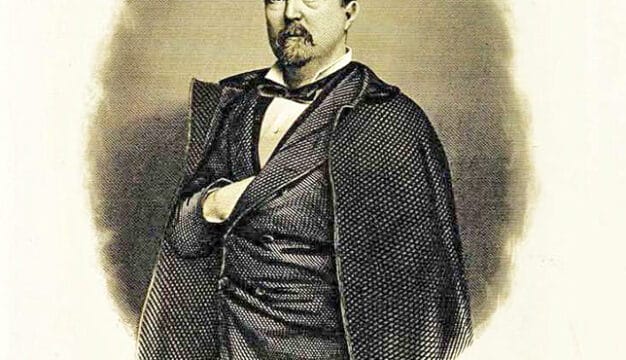Dallas County
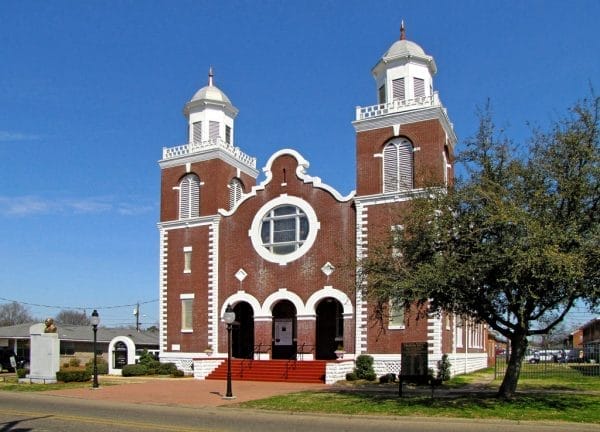 Brown Chapel A.M.E. Church in Selma
A center of the civil-rights struggle, Dallas County is home to Selma, starting point of the famous Selma to Montgomery March. The county was also the site of Cahaba, the state’s first capital as well as the largest historic district in Alabama. The county is governed by an elected four-member commission and includes four incorporated communities.
Brown Chapel A.M.E. Church in Selma
A center of the civil-rights struggle, Dallas County is home to Selma, starting point of the famous Selma to Montgomery March. The county was also the site of Cahaba, the state’s first capital as well as the largest historic district in Alabama. The county is governed by an elected four-member commission and includes four incorporated communities.
- Founding Date: February 9, 1818
- Area: 975 square miles
- Population: 38,184 (2020 Census estimate)
- Major Waterways: Alabama River, Cahaba River
- Major Highways: U.S. 80
- County Seat: Selma
- Largest City: Selma
History
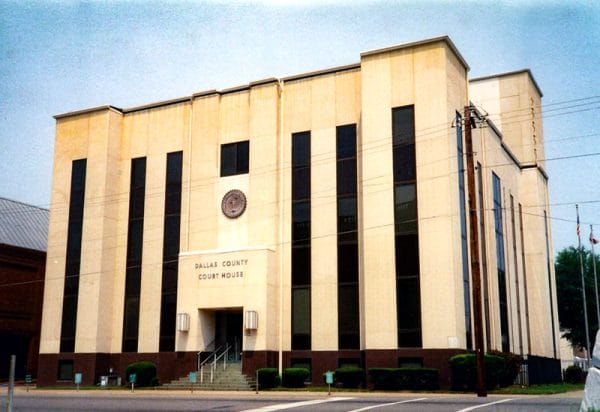 Dallas County Courthouse
Dallas County was created by an act of the Territorial Legislature on February 9, 1818, almost two years before Alabama became a state. In 1820, Cahaba, a small town located in central Dallas County at the junction of the Cahaba River and the Alabama River, was chosen as the county seat and the capital of the state. The small town soon became a bustling economic and political center, but declined after the seat of state government moved to Tuscaloosa in 1825. During the 1840s and 1850s, the town again attained prominence as a center of the cotton industry, but it was virtually abandoned after the Civil War, when the county seat was moved to Selma. The town of Selma, located on a bluff overlooking the Alabama River, was officially recorded in 1732 as Ecor Bienville, then later as the Moore’s Bluff settlement. It was chartered in 1819 by William Rufus King, state senator and vice president to Franklin Pierce. Given its location on the Alabama River, Dallas County quickly developed as an important cotton-producing area, typified by large-scale plantation agriculture.
Dallas County Courthouse
Dallas County was created by an act of the Territorial Legislature on February 9, 1818, almost two years before Alabama became a state. In 1820, Cahaba, a small town located in central Dallas County at the junction of the Cahaba River and the Alabama River, was chosen as the county seat and the capital of the state. The small town soon became a bustling economic and political center, but declined after the seat of state government moved to Tuscaloosa in 1825. During the 1840s and 1850s, the town again attained prominence as a center of the cotton industry, but it was virtually abandoned after the Civil War, when the county seat was moved to Selma. The town of Selma, located on a bluff overlooking the Alabama River, was officially recorded in 1732 as Ecor Bienville, then later as the Moore’s Bluff settlement. It was chartered in 1819 by William Rufus King, state senator and vice president to Franklin Pierce. Given its location on the Alabama River, Dallas County quickly developed as an important cotton-producing area, typified by large-scale plantation agriculture.
 Selma Naval Foundry
Selma played an important part in the Civil War as a center of the munitions industry. After the fall of New Orleans in 1862, Confederate Chief of Ordinance Josiah Gorgas ordered Mobile’s Mount Vernon Arsenal moved to the more central location of Selma. The Selma Naval Ordnance Works was responsible for manufacturing artillery, and the Confederate Naval Yard constructed the CSS Tennessee to defend Mobile Bay. It is estimated that toward the end of the war the 10,000 workers employed in various Selma factories were producing one-half of the cannons and two-thirds of the ammunition used by Confederate forces. In addition to iron and munitions, the town also produced nitre, used in the making of gunpowder, from nearby limestone caves. Because of its industrial importance, Selma became a crucial target for federal forces. After several thwarted attempts, U.S. Army forces under Gen. James H. Wilson finally reached Selma in April 1865, where they defeated Confederate Gen. Nathan Bedford Forrest’s troops and destroyed the arsenal and factories. The abandoned city of Cahaba also played a role in the war as home of the infamous Confederate Cahaba Federal Prison. After the fall of Selma, more than 1,000 U.S. prisoners kept at Cahaba died when the steamer used to transport them back north, the Sultana, exploded and sank in the Mississippi River.
Selma Naval Foundry
Selma played an important part in the Civil War as a center of the munitions industry. After the fall of New Orleans in 1862, Confederate Chief of Ordinance Josiah Gorgas ordered Mobile’s Mount Vernon Arsenal moved to the more central location of Selma. The Selma Naval Ordnance Works was responsible for manufacturing artillery, and the Confederate Naval Yard constructed the CSS Tennessee to defend Mobile Bay. It is estimated that toward the end of the war the 10,000 workers employed in various Selma factories were producing one-half of the cannons and two-thirds of the ammunition used by Confederate forces. In addition to iron and munitions, the town also produced nitre, used in the making of gunpowder, from nearby limestone caves. Because of its industrial importance, Selma became a crucial target for federal forces. After several thwarted attempts, U.S. Army forces under Gen. James H. Wilson finally reached Selma in April 1865, where they defeated Confederate Gen. Nathan Bedford Forrest’s troops and destroyed the arsenal and factories. The abandoned city of Cahaba also played a role in the war as home of the infamous Confederate Cahaba Federal Prison. After the fall of Selma, more than 1,000 U.S. prisoners kept at Cahaba died when the steamer used to transport them back north, the Sultana, exploded and sank in the Mississippi River.
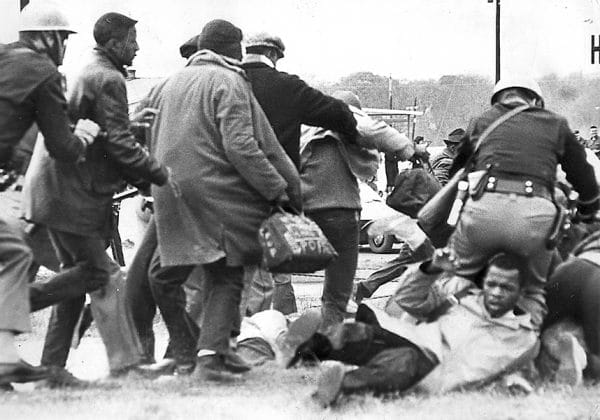 Bloody Sunday
During the 1960s, Selma became an important center of the civil rights movement. The first voter-registration drives, organized in 1960, were met with massive resistance by the white community. In 1965, Dallas County received national media attention when Alabama troopers attacked civil-rights marchers on the Edmund Pettus Bridge on what became known as “Bloody Sunday” during the Selma-to-Montgomery March. In response to the events, Pres. Lyndon B. Johnson signed the Voting Rights Act of 1965.
Bloody Sunday
During the 1960s, Selma became an important center of the civil rights movement. The first voter-registration drives, organized in 1960, were met with massive resistance by the white community. In 1965, Dallas County received national media attention when Alabama troopers attacked civil-rights marchers on the Edmund Pettus Bridge on what became known as “Bloody Sunday” during the Selma-to-Montgomery March. In response to the events, Pres. Lyndon B. Johnson signed the Voting Rights Act of 1965.
Major Cities and Demographics
According to 2020 Census estimates, Dallas County recorded a population of 38,184. Approximately 71.5 percent of respondents identified themselves as African American, 27.2 percent as white, 0.7 percent as Asian, 0.5 percent as two or more races, 0.3 percent as Hispanic, and 0.1 percent as Native American. The county seat, Selma, had a population of 17,762. Other population centers in the county are Valley Grande, Benton, and Orrville. The median household income was $33,317, compared with $52,035 for the state as a whole, and the per capita income was $19,653, compared with $28,934 for the state as a whole.
Economy
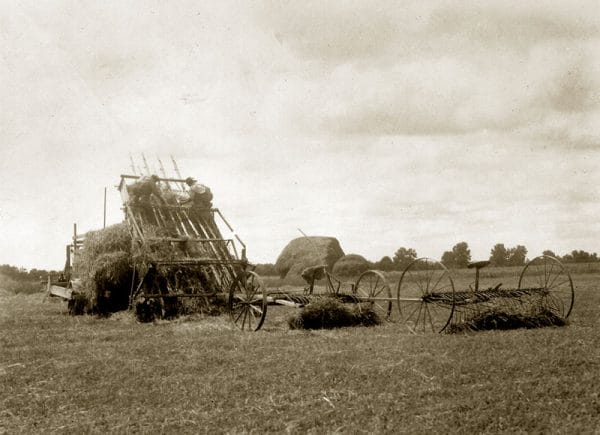 Gathering Hay
Dallas County’s early economy was tied to the plantation agriculture system that typified the Black Belt. In addition, Selma’s proximity to the Alabama River made it a strong economic area during the antebellum period, as steamboats were used to transport the cotton to and from warehouses along the river. In 1836, Dallas County’s economy received a boost when the state chartered the Selma and Tennessee Railroad to connect the Alabama and Tennessee Rivers. The railroad eventually connected Selma to Anniston and linked cotton farmers in north Alabama to Mobile via the Alabama River at Selma. During the Civil War, 10,000 workers were employed in the various munitions and iron factories that sprang up in Selma in response to the Confederate war effort. The economy of Dallas County has steadily declined since the end of the Civil War, and today it remains one of Alabama’s poorest counties, with 35 percent of its residents living below the poverty line.
Gathering Hay
Dallas County’s early economy was tied to the plantation agriculture system that typified the Black Belt. In addition, Selma’s proximity to the Alabama River made it a strong economic area during the antebellum period, as steamboats were used to transport the cotton to and from warehouses along the river. In 1836, Dallas County’s economy received a boost when the state chartered the Selma and Tennessee Railroad to connect the Alabama and Tennessee Rivers. The railroad eventually connected Selma to Anniston and linked cotton farmers in north Alabama to Mobile via the Alabama River at Selma. During the Civil War, 10,000 workers were employed in the various munitions and iron factories that sprang up in Selma in response to the Confederate war effort. The economy of Dallas County has steadily declined since the end of the Civil War, and today it remains one of Alabama’s poorest counties, with 35 percent of its residents living below the poverty line.
Employment
According to 2020 Census estimates, the workforce in Dallas County was divided among the following industrial categories:
- Manufacturing (27.6 percent)
- Educational services, and health care and social assistance (20.2 percent)
- Retail trade (10.1 percent)
- Professional, scientific, management, and administrative and waste management services (8.3 percent)
- Other services, except public administration (6.0 percent)
- Construction (5.7 percent)
- Transportation and warehousing, and utilities (5.2 percent)
- Finance and insurance, and real estate, rental, and leasing (4.7 percent)
- Arts, entertainment, recreation, and accommodation and food services (4.6 percent)
- Public administration (4.5 percent)
- Agriculture, forestry, fishing and hunting, and extractive (1.8 percent)
- Information (1.3 percent)
- Wholesale trade (1.2 percent)
Education
Dallas County Schools currently oversees 14 schools. In addition, Selma City Schools oversees 13 schools. The county is home to Wallace Community College Selma, a two-year public coeducational institution, as well as the private religiously affiliated Selma University and Concordia College, both of which are historically black educational institutions.
Geography
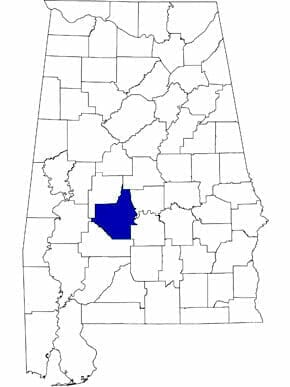 Dallas County Map
Comprising approximately 975 square miles, Dallas County lies in the west-central area of the state, wholly within the Coastal Plain physiographic section. It is bounded to the north by Perry and Chilton Counties, to the east by Autauga and Lowndes Counties, to the south by Wilcox County, and the west by Marengo County. A small portion of the northwest corner of the county lies within the Talladega National Forest.
Dallas County Map
Comprising approximately 975 square miles, Dallas County lies in the west-central area of the state, wholly within the Coastal Plain physiographic section. It is bounded to the north by Perry and Chilton Counties, to the east by Autauga and Lowndes Counties, to the south by Wilcox County, and the west by Marengo County. A small portion of the northwest corner of the county lies within the Talladega National Forest.
The Alabama River runs from north to south through the center of the county, and its tributaries Cedar Creek and Bear Creek traverse the southern and southwestern portions of the county. The Cahaba River joins the Alabama on its northern bank just a few miles south of Selma, and its tributary, Oakmulgee Creek, runs along to the northwestern border of Dallas County. U.S. 80, running east-west through the center of the county, is the county’s major transportation route. Craig Field Airport is the county’s only public airport.
Events and Places of Interest
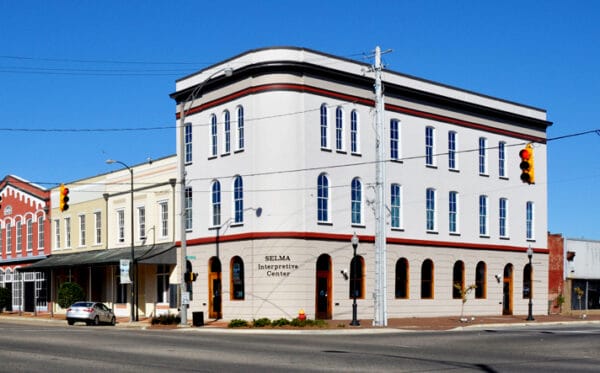 Selma Interpretive Center
The Dallas County city of Selma is home to the state’s largest historic district, with more than 1,250 structures listed on the state and national historic registers. Some of the more notable structures include the St. James Hotel, the Dawson-Vaughan House (home of Elodie Todd, sister-in-law of Abraham Lincoln), and Sturdivant Hall. The Vaughan-Smitherman Museum is a historic building and museum that houses exhibits about the building and the region’s history. Selma also offers visitors a number of exhibits relating to the civil-rights movement at the Old Depot Museum, the National Voting Rights Museum, and Brown Chapel A.M.E. Church, headquarters of the voting-rights marches. The Selma Interpretive Center, operated by the National Park Service, serves as the visitor’s center for the many important civil rights-era sites in the city and offers oral histories about the events of the movement. The Ancient Africa, Enslavement, and Civil War Museum interprets African American history from ancient times up to the Civil War era. Selma’s Old Live Oak Cemetery is one of the few cemeteries listed on the National Register of Historic Places.
Selma Interpretive Center
The Dallas County city of Selma is home to the state’s largest historic district, with more than 1,250 structures listed on the state and national historic registers. Some of the more notable structures include the St. James Hotel, the Dawson-Vaughan House (home of Elodie Todd, sister-in-law of Abraham Lincoln), and Sturdivant Hall. The Vaughan-Smitherman Museum is a historic building and museum that houses exhibits about the building and the region’s history. Selma also offers visitors a number of exhibits relating to the civil-rights movement at the Old Depot Museum, the National Voting Rights Museum, and Brown Chapel A.M.E. Church, headquarters of the voting-rights marches. The Selma Interpretive Center, operated by the National Park Service, serves as the visitor’s center for the many important civil rights-era sites in the city and offers oral histories about the events of the movement. The Ancient Africa, Enslavement, and Civil War Museum interprets African American history from ancient times up to the Civil War era. Selma’s Old Live Oak Cemetery is one of the few cemeteries listed on the National Register of Historic Places.
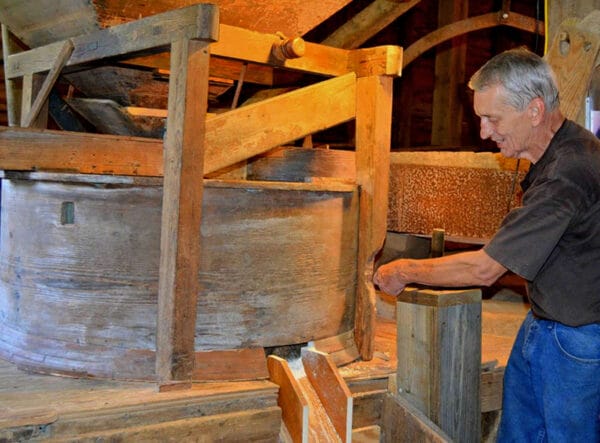 Kenan’s Mill
Each spring, Selma hosts the Annual Pilgrimage, which offers tours of privately owned historic homes, a church tour, an antique show and sale, a bus tour of Old Town, a tour of Kenan’s Mill living-history park, and a twilight living history tour at Old Live Oak cemetery. In October, Selma hosts the Tale Tellin’ Festival. Founded in 1978 by renowned Alabama storyteller Kathryn Tucker Windham, the festival features music, food, and some of the top storytellers in the nation. Also in October is the Selma annual Riverfront Market Day, which includes vendors, music, and arts and crafts.
Kenan’s Mill
Each spring, Selma hosts the Annual Pilgrimage, which offers tours of privately owned historic homes, a church tour, an antique show and sale, a bus tour of Old Town, a tour of Kenan’s Mill living-history park, and a twilight living history tour at Old Live Oak cemetery. In October, Selma hosts the Tale Tellin’ Festival. Founded in 1978 by renowned Alabama storyteller Kathryn Tucker Windham, the festival features music, food, and some of the top storytellers in the nation. Also in October is the Selma annual Riverfront Market Day, which includes vendors, music, and arts and crafts.
Visitors can tour the ruins of the first state capital at the Old Cahawba historical park. The site is maintained by the Alabama Historical Commission and is open daily. Visitors can tour the abandoned town themselves or take a guided tour.
Further Reading
- Heritage of Dallas County, Alabama. Clanton, Ala.: Heritage Publishing Consultants, Inc., 2004.
- Jackson, Walter M. The Story of Selma. Birmingham, Ala.: The Birmingham Printing Company, 1954.
External Links
- Dallas County
- Dallas County Schools
- City of Selma
- City of Valley Grande
- Selma-Dallas County Public Library
- Selma and Dallas County Chamber of Commerce
- National Register of Historic Places: Dallas County
- Selma Interpretive Center
- Old Depot Museum
- Old Cahawba
- National Voting Rights Museum and Institute
- Wallace Community College Selma



